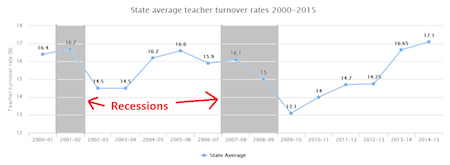How high is teacher attrition? How much does it change over time, and why? We don’t have great answers to these questions, but a story and graphic from Chalkbeat Colorado helps provide some tentative answers.
Chalkbeat’s story covered a newly released dataset from the Colorado Department of Education tracking teacher retention rates over the last 15 years.* The article featured a graph showing changes over time; I’ve reproduced it below with some slight modifications.

Two things jumped out at me when I saw this chart. First, although teacher attrition goes up and down somewhat year-to-year, it was nearly identical in 2013-14 as it was in 2001-2 and 2005-6. From high to low and back again, teacher attrition in Colorado has stayed in a relatively small band of 3-4 percentage points. (Note that the graph’s y-axis accentuates these changes. If the graph started at 0 percent, the changes would look even smaller.)
Second, note what happens during recessions. I added the vertical gray bars to correspond to the school years in which a recession hits (using the official NBER recession dates). As the economy contracts and it becomes harder to find gainful employment, fewer Colorado teachers leave their jobs. The deeper, longer recession after the financial meltdown in 2007-9 appears related to even lower teacher attrition rates. And then, as the economy begins to expand, teacher attrition rates start climbing again. There’s a natural cycle of teacher mobility in Colorado, and it seems to be tied to the larger, national economic picture.
These things are important, because it suggests that there are much larger forces at play in teacher retention decisions than whatever education cause du jour receives the blame. Through the implementation of No Child Left Behind, the Common Core, new teacher evaluations, the expansion of Teach for America, changes in the state’s teacher pension plan, the rise of charter schools, the testing opt-out movement, etc., teacher attrition in Colorado has stayed pretty much the same.
None of this should diminish concerns about teacher retention. And there are large differences in teacher retention rates between Colorado districts, meaning some have much higher turnover rates than others. But we’d be wise to assume that big, major trends in the economy like unemployment rates and wages have at least as big of an impact on teacher mobility as specific education policy changes.
*NOTE: The rates consider a teacher as having “turned over” if they leave teaching, leave Colorado, or leave their school district.
—Chad Aldeman
This post originally appeared on Ahead of the Heard.


